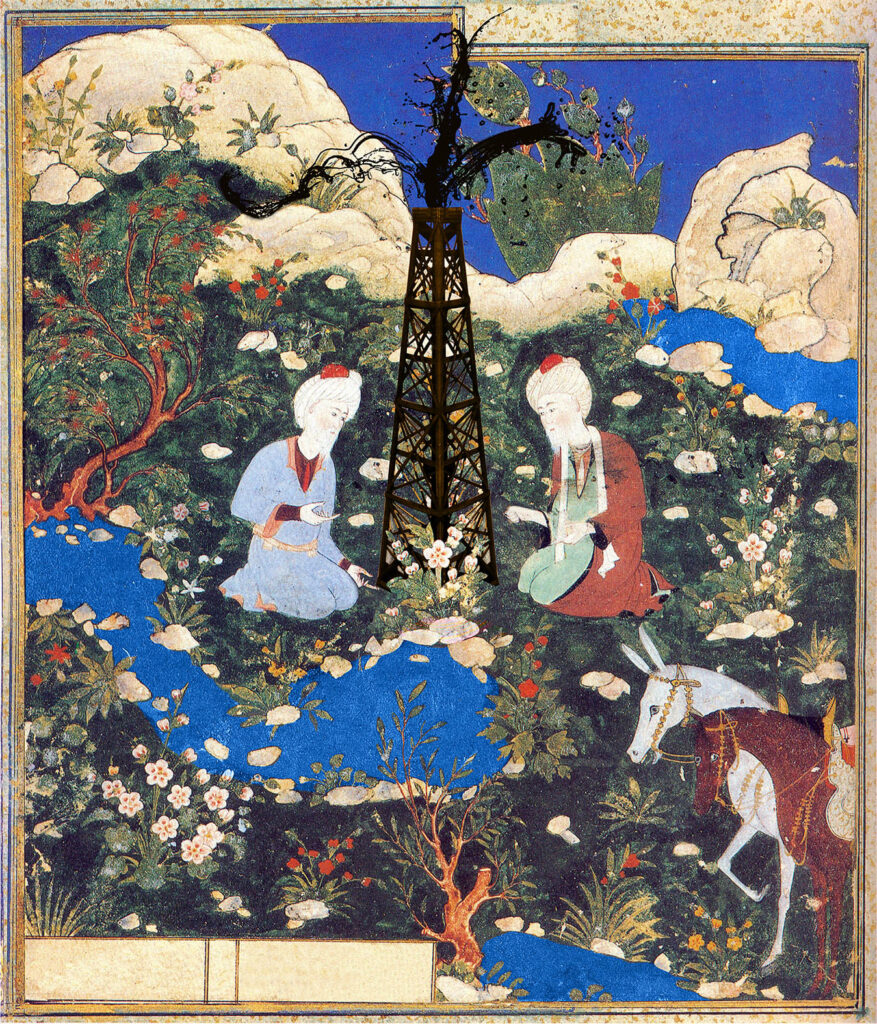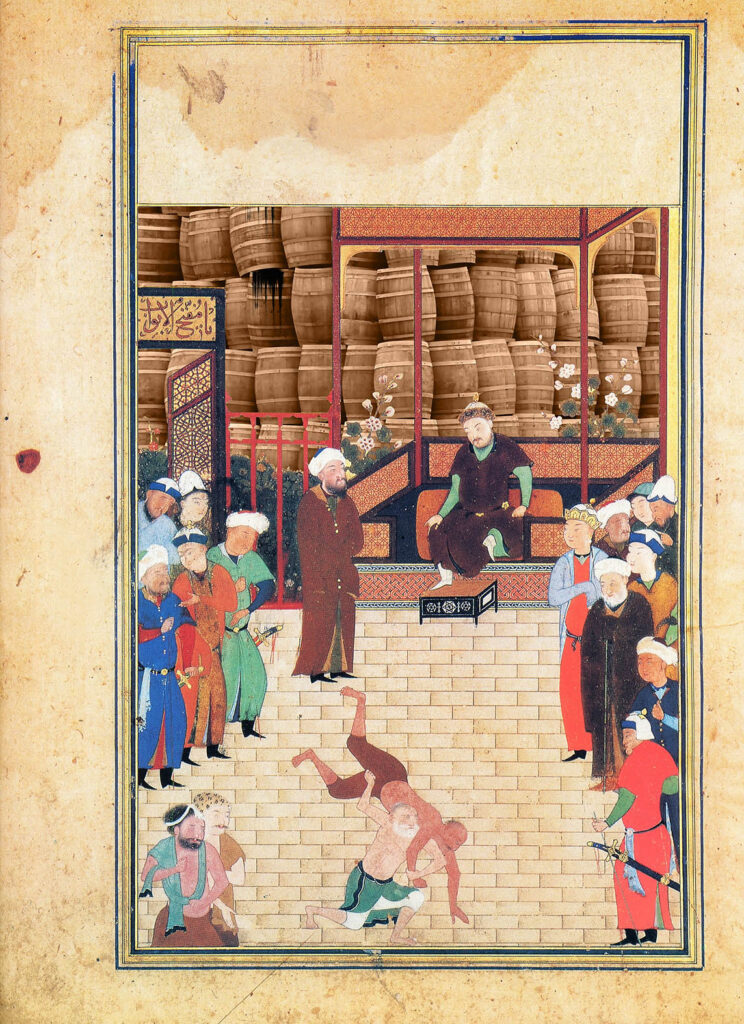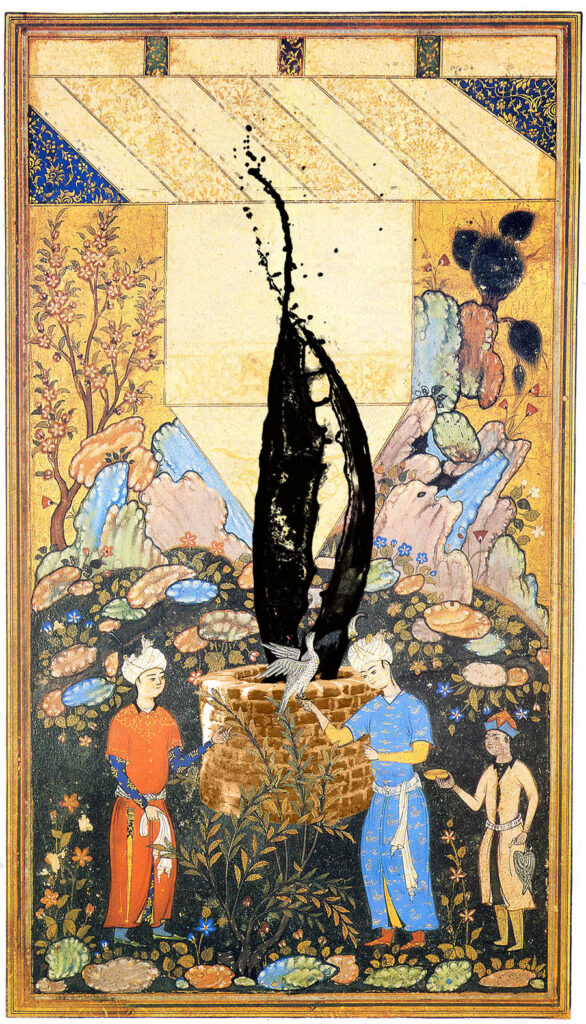Digital painting, Photo Print, 2011
Iranian plateau is warm and dry, with scalding hot, waterless, barren deserts, very few seasonal rainfall and lots of long-term droughts. Its rivers flow into deserts, swamps, and into salt-marshes and salt-water lakes; therefore, with water being scarce, life was formed around the few fresh-water springs.
As the time passes, and the population around the spring grows, the need for a force to ration the scarce water rises; a powerful force, a strong arm, the force that, at times, boasts about its power to show it off! So the eyes stare at the only hand that rations life and existence, and the landscapes that will bear plants are those at the mercy of the fierce force, for the soil without water is barren.
In the ancient Persian miniature paintings, the gold depicted the sky, and the silver the river. Every color, every stroke, was to envision and portray a mesmerizing, illusion; a land beyond existence, but with the passage of time, the golden skies were cracked, peeled and fell apart. The brilliant, clear river, little by little, oxidized to black, never again to quench the thirst of lovers, the deer, or that of plants.


Ali Ettehad: “It has been thousands of years that water has created such a pattern in Iran. I imagine that during the 20th century this pattern was transferred from water to oil. Now oil wells have taken the place of water springs and the hard core of power is built around these wells. Oil helped to keep the power pyramid structure unchanged. Now, instead of the water and moisture blackening the silver rivers, it is the oil that has blackened everything. Modern times have arrived, but in my motherland, patterns have not been broken.”

Saadi Shirazi ( 1438-1506 C.E) from The Gulistan (book – 1258 C.E):
A man had attained great excellence in the art of wrestling, who knew three hundred and sixty exquisite tricks and daily exhibited something new. He had a particular affection for the beauty of one of his pupils whom he taught three hundred and fifty-nine tricks, refraining to impart to him only one. At last the youth had attained such power and skill that no one was able to contend with him and he went so far as to say to the sultan: ‘I allow superiority to my teacher on account of his age and from gratitude for his instruction but my strength is not less than his and my skill equal.’ The king, who was not pleased with this want of good manners, ordered them to wrestle with each other and a spacious locality having been fixed upon, the pillars of state and courtiers of his majesty made their appearance. The youth made an onslaught like a mad elephant with an impulse which might have uprooted a mountain of brass from its place but the master, who knew that he was in strength superior to himself, attacked him with the rare trick he had reserved to himself and which the youth was unable to elude; whereon the master, lifting him up with his hands from the ground, raised him above his head and then threw him down. Shouts were raised by the spectators and the king ordered a robe of honor with other presents to be given to the teacher but reproached and blamed the youth for having attempted to cope with his instructor and succumbed. He replied: ‘My lord, he has not vanquished me by his strength but there was a slender part in the art of wrestling which he had withheld from me and had today thereby got the upper hand of me.’ The master said: ‘I had reserved it for such an occasion because wise men have said: “Do not give so much strength to thy friend that, if he becomes thy foe, he may injure thee.” Hast thou not heard what the man said who suffered molestation from one whom he had educated?
Either fidelity itself does not exist in this world
Or nobody practices it in our time.
No one had learnt archery from me
Without at last making a target of me.’
The original of this painting was made during the reign of Sultan Husayn Bayqara. Timurid Sultan who patronized painters, poets and Sufis. In front of him stands one of the most important cultural and political figures of that time, namely Wazir Sultan Husayn; Ali-Shir Nava’i. Although this picture was made three hundred years after Saadi’s book, the royal painter placed him and his minister in the middle of Saadi’s story in order to please the Sultan. Now, behind the sultan’s head, barrels of black oil have been added to the picture. The Sultan, who is the patron of art, also sits on the same pyramid of power. According to the artist, a pattern is related to oil in a strange way.




